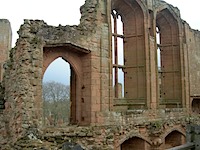Interwoven in the lives of English Royalty from the Normans to the Tudors.
Kenilworth Castle, just a few miles from Warwick Castle, is one of the largest ruins is the country. Although less well known than it's neighbour, Kenilworth played an important role throughout the Norman and Tudor periods of our history and remains one of the most inspirational castles we have.
Kenilworth Castle is huge. It owes it's size to the various additions made over the years by it's royal owners. Construction of the giant keep began around 1120. During the reign of Henry II, it was strengthened, and again by his son, King John in 1210 and 1215. John was responsible for having the water defences put in place, which provided Kenilworth with an almost impregnable lake barrier.
During the reign of King John's son, Henry III, the castle was given to his sister's husband, Simon de Montfort. After de Montford's revolt and success against Henry at the battle of Lewes, Henry's son, Prince Edward (later to become King Edward I),was taken hostage by de Montfort, and held captive for a time at Kenilworth.
But Simon's luck ran out at Evesham, where he was killed in 1265. His followers fled to the incredibly strong fortress at Kenilworth, where in 1266, protected by the water defences, they withstood a bitter siege for six months, probably the longest siege in English history.
Edward I's son, the infamous Edward II visited here with his wife, the long suffering Queen Isabella of France, at Christmas 1323. Their relationship was at a dangerous stage, and by 1326 the king had been deposed by a coalition of forces lead by his wife and her lover, Roger Mortimer. The queen, knowing the strength of the castle, had Edward imprisoned here, and it was in the Great Hall that Edward resigned as king on the 21st of January 1326.
Edward was later taken to Berkeley Castle, where he was murdered (or not murdered, depending on your reading of history - it's one of the great unsolved historic mysteries).
The next great character to be associated with Kenilworth was John of Gaunt, son of King Edward III. John of Gaunt had grand aspirations. His second wife was heiress to Castile and John aspired to a crown. He had major works carried out at Kenilworth, transforming it into a palace. The marriage was not a happy one, and John never did attain the crown he wanted, but Kenilworth benefited. As you walk around, the almost cathedral like windows remind you of the splendour once achieved here.
If you like a touch of romance with your history, read Alison Weir's book about Katherine Swynford, John's long-term mistress and eventually his wife. She was a presence for many years in his life, and seems to have been a marvellous woman. The Beaufort family descend directly from the children she bore him. I loved the book because it gave a wonderful account of two lovers, growing old, together and apart.
Shakespeare lovers will remember the scene in Henry V when Henry receives the chest of tennis balls from the French - an insult to his manhood which is said led to the Agincourt campaign of 1415. The real event took place at Kenilworth. It was a favourite residence of the young king.
The last and proably greatest royal connection the castle boasts, concerns Robert Dudley, Earl of Leicester and Queen Elizabeth I's most beloved favourite. Robert Dudley did what John of Gaunt had done, nearly two hundred years earlier, he transformed the castle into a palace fit for his queen. She came here in July 1575, spending 19 days with her Robert, one of her longest stays at any country house on her many travels.
The castle is now under the care of English Heritage, who have recently recreated the Elizabethan garden she would have seen in 1575.
Kenilworth has inspired writers and artists over the centuries. It retains a grandeur despite being ruined and remains an unforgettable place to visit.





